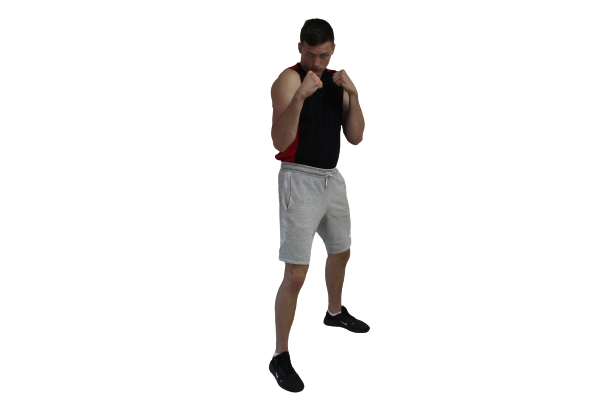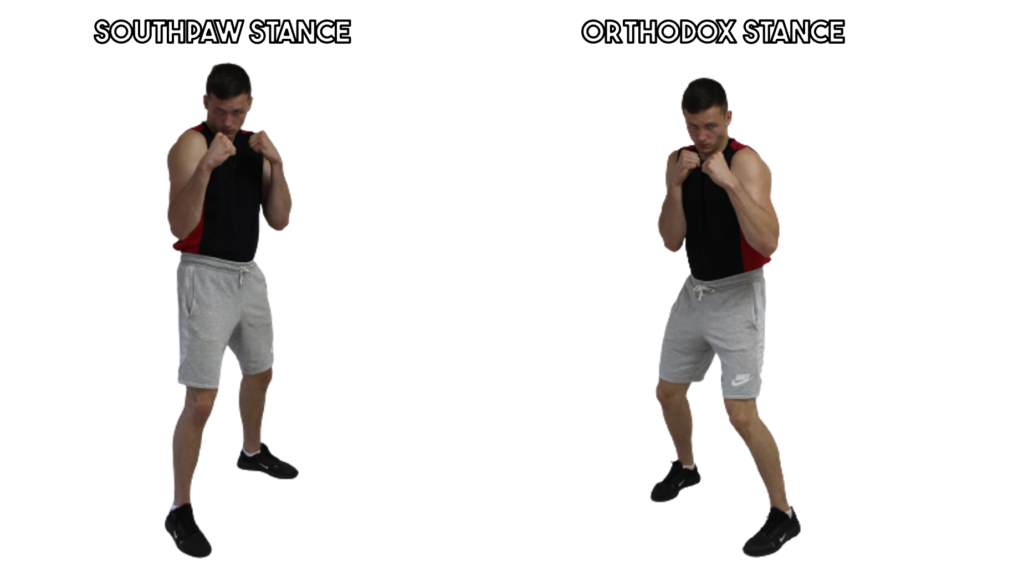In this article, we will comprehensively cover the southpaw stance and its fighting style in boxing. Specifically, we’ll go into what is a southpaw in boxing, southpaw vs. orthodox, notable southpaw fighters, advantages and disadvantages, and common myths of the southpaw fighting style.
So you started getting into boxing and heard the term ‘southpaw’.
You might have loads of questions about what it is, its tactics, advantages and disadvantages, if you should adopt the stance, etc.
Worry not.
In this comprehensive guide, I will delve into the essence of the style in boxing!
You will find all your answers here.
If you want a quick table of contents that will inform you of what is going to happen in this article, you can skip ahead here:
What Is Southpaw In Boxing?
To put it very simply, a southpaw in boxing, is a fighter who leads with their right hand and right foot, making their left hand their power punch when in the boxing stance.
This positioning is the mirror opposite of the more common orthodox stance, where fighters lead with their left hand and left foot.

The defining characteristic of a southpaw boxer is that their left hand becomes their power hand, responsible for delivering powerful punches such as the left cross.
Conversely, their right hand is typically used for throwing boxing jabs and setting up their more potent left-handed attacks.
People often simplify and state that to some extent, the stance is a reversal of a classic orthodox style (left hand and left leg forward).
It is only true to a certain extent.
There is more to southpaw positioning than just reversal of the orthodox stance!
The stance’s positioning creates unique angles of attack and defence, and unique challenges that are not reversal to orthodox, but simply different.
But I will cover this soon.
Lastly, as an interesting fact, I can add that the term “southpaw” is not a boxing term!
It originates from the baseball world, where left-handed pitchers would face south about the diamond!
Southpaw vs. Orthodox Stance: Similarities And Differences?
In the world of boxing, stances serve as the foundation upon which a fighter’s strategy is built.
The southpaw and orthodox stances are two prominent pillars in this realm, offering both similarities and differences that shape the dynamics of a match.
Below, I will compare and contrast those stances so you will be able to understand both of them.

Similarities
Let’s start with the similarities!
While they might seem like opposites at first glance, the two stances share a few fundamental elements.
Guard and Defence
Both stances prioritize guarding the head and body from incoming strikes using their hands.
Due to this, the basic principles of slipping, blocking, and parrying are relevant regardless of the stance.
Footwork
Footwork is a cornerstone of boxing, irrespective of stance.
Both stances utilize foot movement to create angles, close gaps, and maintain distance.
Therefore, the basic elements of footwork for offensive and defence in boxing will apply to both stances.
Strategic Thinking
The mental aspect of boxing is universal.
Fighters in both stances must analyze their opponents, anticipate moves, and strategize effectively to gain an upper hand.
Neglecting this will result in the same outcome, regardless of the boxers’ stance—defeat.
Differences
As you can see many of the basics are very similar! At the end of the day, it’s boxing.
Nonetheless, there are some serious differences:
Lead Hand and Foot
The most glaring difference lies in the positioning of the lead hand and foot.
In the Orthodox stance, the left hand and left foot are forward, while in the Southpaw stance, it’s the right hand and right foot.
Angles and Movement
Southpaws often create unique angles due to their stance, catching orthodox opponents off-guard.
For example, because a southpaw fighter has his or her leading foot right in front of an orthodox fighter’s front foot, he or she can pivot to the outside.
Counterpunching Dynamics
The counterpunching opportunities and strategies differ due to the positioning of the power hand.
Southpaws counter with their left hand, whereas orthodox fighters counter with their right.
Conclusion: Southpaw vs. Orthodox
In essence, while Southpaw and Orthodox stances present distinct tactical advantages and challenges, they are intricately connected by the art of boxing.
Each stance requires a thorough understanding of the opponent’s strengths and weaknesses and demands a tailored approach to capitalize on the unique opportunities they provide.
The rivalry between these stances enriches the sport by showcasing the diversity of skills, strategies, and mindsets that make boxing a captivating spectacle.
Notable Southpaw Boxers
Before proceeding to analyse some of the advantages and disadvantages of the southpaw style, I would like you to stop for a minute and actually see the style in action.
There are no better examples to show the fighting style than present you with one of the greatest lefties of all time.
Have a look at them, their style and how they utilised the stance.
Marvin Hagler: a relentless middleweight champion known for his aggressive style and devastating left hand.
Manny Pacquiao: an eight-division world champion celebrated for his speed, footwork, and explosive left cross.
Pernell Whitaker: a defensive wizard who utilized his southpaw stance to avoid punches and counter with precision. Interestingly, one of the favourite fighters of Floyd Mayweather.
Oscar De La Hoya: a versatile fighter who seamlessly transitioned between orthodox and southpaw stances to keep opponents guessing.
It was no accident that I used Oscar De La Hoya as an example in those videos!
He is one of the few boxers who switched the styles from southpaw to orthodox.
Why?
This is partly because of the advantages and disadvantages of the southpaw style that I will uncover in the chapter below.
Advantages & Disadvantages of Southpaws
As with everything, the Southpaw style has its advantages and disadvantages.
Below I will mention the 4 most common of them and allow you to see for yourself whether you believe that the stance is superior, inferior, or equal to the orthodox boxing style.
Advantages
Unfamiliar Angles
Orthodox fighters mostly face other orthodox fighters.
This is natural as most people are right-handed rather than left-handed.
Because of this, southpaws will have more experience fighting opponents who fight in the orthodox stance, but the reverse is not true.
As such, the stance can create and exploit angles that orthodox fighters might not be accustomed to, leading to increased difficulty for orthodox fighters to defend and counterattack.
Surprise Power
Orthodox fighters are more accustomed to facing opponents who throw their power punches using their right hand.
The left hand, typically the power punch for southpaws, can therefore catch opponents off guard and deliver unexpected knockout blows.
If you train your punching power routinely, it could amplify the advantage.
Strategic Edge
The rarity of southpaw fighters can give them a strategic advantage by exploiting opponents’ lack of experience against opponents using the southpaw stance.
This gives a great strategic edge, as the orthodox fighter’s lack of experience will make the fighter more predictable.
So, this allows the southpaw fighter to plan a few steps ahead of his or her opponent.
Counterpunching Opportunities
Southpaws can capitalize on counterpunching opportunities.
Specifically, by using their lead right hand to parry or block an opponent’s jabs and hooks while setting up powerful left-handed counters.
Disadvantages
Exposed Liver
By far the biggest disadvantage of the stance.
Boxers using the southpaw stance have their liver on the side that is in proximity to their opponent.
When in the orthodox position, your liver (pain point) is well hidden and protected.
In southpaw, however, it is relatively exposed.
Limited Sparring & Training Partner
There are a lot more orthodox boxers than southpaw boxers.
So finding suitable sparring partners to simulate the challenges of facing a southpaw may be difficult, especially if the boxer wants to learn to face other southpaw fighters.
This also extends to general training.
Most boxing trainers are used to train orthodox boxers due to being a lot more common.
As such, it may be more difficult for southpaw boxers to find suitable trainers or training partners to due boxing drills.
Generally Vulnerable Defence
The unconventional stance can expose the right side of a southpaw fighter.
That makes them more susceptible to right-handed attacks.
Limited Defensive Moves
The positioning of the southpaw stance can limit certain defensive moves.
For example, using the lead hand for blocking and parrying.
This can require southpaws to develop alternative defensive strategies to protect themselves effectively.
Debunking Myths Surrounding the Southpaw Style
By now, you should know decently about the southpaw boxing style.
However, you might still have a wrong impression about the boxing stance because of previously hearing many myths created and spread by boxing beginners who do not understand it or know much about it.
So let’s debunk the 4 most common myths behind the style to give you a better idea of what it is and what it is not.
Myth 1: Southpaw Stance Is Always Advantageous
The southpaw stance offers unique advantages when fighting an opponent in a boxing ring.
… but, it’s not a guaranteed recipe for success.
What really determines success is the fighter’s skill, adaptability, and strategy.
More specifically, if the fighter knows the strengths and weaknesses of the opponent’s stance and strategies and is able to manoeuvre around them through the fighter’s skills and adaptability, then he or she will be able to succeed and win.
Myth 2: Southpaws Have A Natural Advantage In Boxing
Some fighters may feel more comfortable in the southpaw stance due to their natural handedness.
However, success in boxing comes down to skill development, hard work, and training, and not on using a specific stance and technicality.
As I previously mentioned, the stance has several advantages, but at the same time, has disadvantages not present in the orthodox stance.
It is incorrect to assume that boxers are better off fighting in the southpaw stance than in the orthodox stance.
Myth 3: Southpaw Fighters Are More Injury-Prone
Not sure where this myth came from, but it’s surprisingly common among boxing beginners.
Injuries in boxing are not limited to a specific stance.
Rather, proper conditioning, technique, and training play an important role in minimising the risk of injuries regardless of the boxer’s stance.
Myth 4: Southpaw Stance Guarantees Unpredictability
While the southpaw stance can indeed introduce unpredictable angles of attack, it’s a misconception to assume that southpaw fighters are inherently unpredictable.
Experienced opponents, trainers, and coaches often study and analyse various fighting styles, including southpaw stances, to develop effective strategies.
Over time, familiarity with facing southpaw fighters can diminish the element of surprise, emphasizing the importance of skill and adaptability over mere unpredictability.
Conclusion
In conclusion, we covered everything there is to know about being a southpaw.
Specifically, we covered the definition of a southpaw and how it is similar or different to the standard stance in boxing—the orthodox stance.
We also went through notable southpaw boxers. Finally, we covered the advantages, disadvantages, and misconceptions behind the boxing stance.
Hopefully, now you are better equipped to choose your style, understand your style, understand the style of your opponent, or simply enjoy boxing fights.
Enjoy.